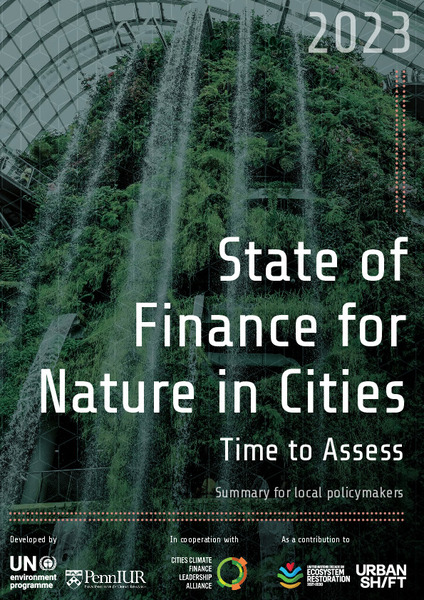| dc.contributor | Industry and Economy Division | en_US |
| dc.contributor.author | United Nations Environment Programme | en_US |
| dc.contributor.author | Penn Institute for Urban Research, University of Pennsylvania | en_US |
| dc.contributor.author | Cities Climate Finance Leadership Alliance | en_US |
| dc.coverage.spatial | Global | en_US |
| dc.date.accessioned | 2024-05-29T13:04:44Z | |
| dc.date.available | 2024-05-29T13:04:44Z | |
| dc.date.issued | 2023 | |
| dc.identifier.uri | https://wedocs.unep.org/20.500.11822/45610 | |
| dc.description | Nature-based solutions can help cities become more resilient, healthy and equitable. But for urban nature to reach its full potential, investments need to be substantially scaled up. In 2020, NbS received just 0.3% of overall spending on urban infrastructure, and investments are unequally distributed across and within cities. With this publication, UNEP and the Penn Institute for Urban Research outline gaps and opportunities for NbS financing in cities, best practices from around the world, and actions that local governments, financial stakeholders, private sector and knowledge partners can take to scale up investments for nature in cities. | en_US |
| dc.format | pdf | en_US |
| dc.language | English | en_US |
| dc.relation.ispartof | State of Finance for Nature | en_US |
| dc.rights | Public | en_US |
| dc.subject | NATURE-BASED SOLUTION | en_US |
| dc.subject | ENVIRONMENTAL FINANCING | en_US |
| dc.subject | CITIES | en_US |
| dc.subject | INVESTMENTS | en_US |
| dc.subject | CASE STUDIES | en_US |
| dc.title | State of Finance for Nature in Cities 2023: Time to Assess - Summary for local policymakers | en_US |
| dc.type | Briefs, Summaries, Policies and Strategies | en_US |
| wd.identifier.sdg | SDG 14 - Life Below Water | en_US |
| wd.identifier.sdg | SDG 15 - Life on Land | en_US |
| wd.topics | Finance and Economic Transformations | en_US |
| wd.topics | Nature Action | en_US |
| wd.identifier.pagesnumber | 18 p. | en_US |


